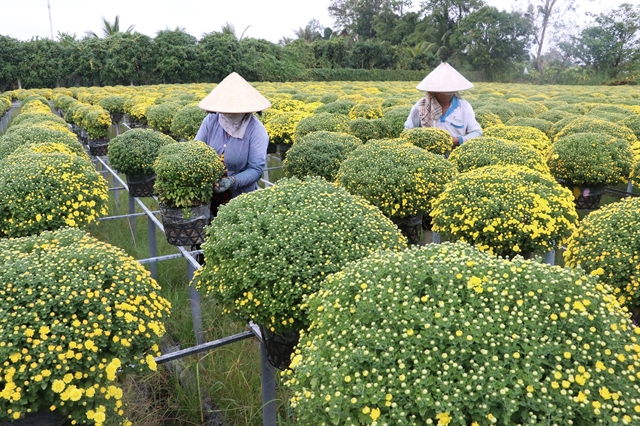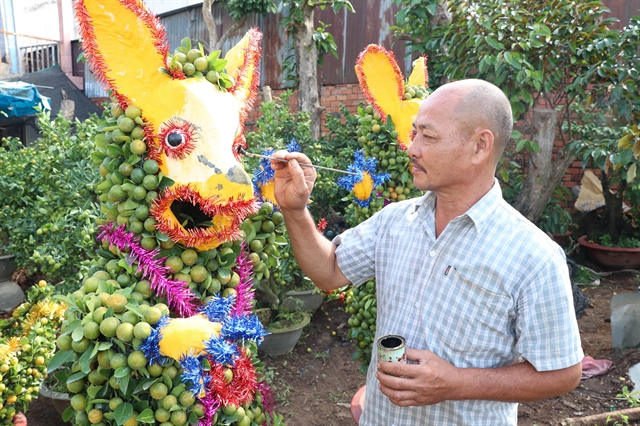 Society
Society

Farmers in the Cửu Long (Mekong) Delta region are expected to have a good flower and ornamental plant harvest, as well as good prices, for the Tết (Lunar New Year) festival, which falls on January 25.

|
| Farmers tend chrysanthemum pots in Sa Đéc flower village in Đồng Tháp Province. – VNA/VNS Photo Nguyễn Văn Trí |
HCM CITY — Farmers in the Cửu Long (Mekong) Delta region are expected to have a good flower and ornamental plant harvest, as well as good prices, for the Tết (Lunar New Year) festival, which falls on January 25.
Many well-known flower and ornamental plant villages exist in the delta, including Sa Đéc in Đồng Tháp Province, Chợ Lách in Bến Tre Province, Phó Thọ - Bà Bộ in Cần Thơ City and Mỹ Tho in Tiền Giang Province.
In Sa Đéc flower village in Sa Đéc City, the largest flower village in Đồng Tháp Province, about 2 million pots of various kinds of flowers are being grown for Tết, including more than 250,000 chrysanthemum pots.
Traders are buying chrysanthemum pots in advance for prices ranging VNĐ80,000 to 90,000 (US$3.5 – 3.9) a pot, up VNĐ20,000 – 30,000 against the last Tết.
Farmers are earning a profit of VNĐ30,000 – 50,000 for each chrysanthemum pot. Chrysanthemums, one of the preferred Tết flowers, can bloom for more than one month.
Phạm Văn Hóa, who grows 6,000 chrysanthemum pots in Sa Đéc City’s Tân Quy Đông Ward, said that the flower was blooming on time for Tết and was more beautiful this year because of favourable weather.
The price of various types of flowers in the village has also increased by 20 – 30 per cent compared to last Tết, he said.
With advanced farming techniques, farmers in the delta can now make most flowers bloom during Tết to fetch good prices.
The quantity of flower and ornamental plants grown for Tết in many flower villages has increased this year. Farmers have also planted more new flower varieties such as foreign rose and daisy varieties.
In An Giang Province, more farmers in Ông Hổ Islet in Long Xuyên City’s Mỹ Hòa Hưng Commune, are growing ochna for Tết. Ochna is a traditional Tết flower in the southern region.
Trần Anh Châu, chairman of the Mỹ Hòa Hưng Commune Farmers Association, said the number of households in the commune growing ochna trees for the coming Tết increase four times against last Tết because of the high market demand.
Since farmers in the commune use natural methods, the ochna trees produce more flowers over the years. They also look more beautiful with each year.
Đinh Ngọc Tùng, head of the Mỹ Tho City Economic Bureau in Tiền Giang Province, said farmers in the city are growing more than 1 million pots of various types of flowers for Tết, including 800,000 pots of daisy varieties.
The weather has been favourable, but the prices of materials and worker costs have increased by 10 -15 per cent against last Tết. As a result, the prices of flowers will increase, according to farmers in Mỹ Tho.
In Bến Tre Province’s Chợ Lách District, which is the delta’s largest flower producer, farmers will supply about 11 million pots of flowers and ornamental plants to the market, according to the Chợ Lách Bureau of Agriculture and Rural Development.
Chợ Lách District produces many ornamental plants in various shapes, including the animals representing the 12-year zodiac cycle, in which each year is related to one animal.
The coming Tết is the Year of the Rat, so the district is making many ornamental plants in the shape of the rat.
High income
Lê Văn Kiết, an artisan who grows ornamental plants in Chợ Lách’s Vĩnh Thành Commune, said he was making many plants in the shape of the rat for Tết. “Many people like buying such ornamental plants.”
Bùi Thanh Liêm, head of the Chợ Lách Bureau of Agriculture and Rural Development, said artisans who make plants in the shape of animals and towers can sell them at a high price. Plants with a height of 1.5m can sell for VNĐ2 – 2.5 million a pot.
The cultivation of flowers and ornamental plants for Tết has provided farmers in the delta a good income.
Nguyễn Thị Phượng, who grows Tết flowers in An Khương flower village in Châu Thành District’s Minh Hòa Commune in Kiên Giang Province, said she earn a profit of VNĐ30 - 40 million ($1,300 – 1,700) for each Tết flower crop.
“Growing flowers for Tết has led to financial stability for our family. So we will have a good Tết celebration and have money for my children's education,” she said.
Trần Bá Hiệp, chairman of the Minh Hòa Commune Farmers Association, said the An Khương flower village has weather and soil suited for growing flowers. Farmers make a profit four – five times higher from flowers than from rice, he said.
The village, the largest flower growing area in Kiên Giang Province, is expected to supply about 500,000 flower pots for the coming Tết, with an estimated average price of VNĐ30,000 – 45,000 ($1.3 - 2) a pot. The village farmers grow mostly daisies, cockscomb, marigold and sunflowers.
Flowers and ornamental plants in the delta’s villages are sold elsewhere in the delta and other provinces and cities, including HCM City.
Besides growing flowers and ornamental plants for sale, many flower villages in the delta offer tourism services. — VNS

|
| An artisan makes an ornamental plant pot in the shape of the rat for Tết in Bến Tre Province. The coming Tết is the Year of the Rat. – VNA/VNS Photo Huỳnh Phúc Hậu |









